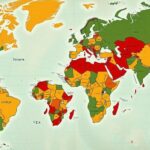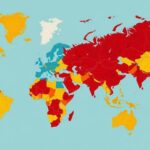Politics
AFRICA, ANGOLA, ASIA, BANGLADESH, BOSNIA AND HERZEGOVINA, BOTSWANA, CAMBODIA, CHINA, DONALD TRUMP, EUROPE, EXPORTS, FALKLAND ISLANDS, GUYANA, INDIA, INDONESIA, INTERNATIONAL TRADE, INVESTMENTS, IRAQ, LAOS, LESOTHO, MADAGASCAR, MEXICO, MYANMAR, NORTH AMERICA, NORTH MACEDONIA, REUNION, SAINT PIERRE AND MIQUELON, SERBIA, SOUTH AMERICA, SRI LANKA, SYRIA, THAILAND, TRADE, TRUMP, UNITED STATES, US, VIETNAM, WHITE HOUSE, WHITE HOUSE ROSE GARDEN
Nia Simpson
President Trump Implements Sweeping Tariffs on Imports
President Trump has unveiled a new tariff structure imposing a baseline 10 percent tax on imports, with higher rates for specific countries. This strategy, termed a “declaration of economic independence,” aims to boost domestic production but could lead to retaliatory actions and increased consumer prices, as per economists’ warnings.
On Wednesday, President Donald Trump announced an extensive set of tariffs, imposing a baseline 10 percent tax on all imports. Additionally, he introduced significantly higher rates targeting specific countries with which the United States maintains trade deficits. Trump’s initiative, presented in the White House Rose Garden, was characterized as a “declaration of economic independence” aimed at enhancing domestic production through fair competition with foreign entities.
The new tariff regime includes a flat 10 percent rate on all imports, with elevated tariffs for several major trading partners. Cambodia faces the highest tariff at 49 percent, followed by Vietnam at 46 percent, Sri Lanka at 44 percent, and China at 34 percent. Furthermore, Trump declared a 26 percent “discounted reciprocal tariff” on imports from India, aimed at establishing equitable trade relations.
The complete list of reciprocal tariffs details numerous countries affected. Countries imposing tariffs of 40 percent and above include Lesotho and Saint Pierre and Miquelon, both at 50 percent, followed by Cambodia at 49 percent, Laos at 48 percent, and Madagascar at 47 percent. Other notable mentions are Vietnam and Sri Lanka, each at 44 percent, with China facing a tariff of 34 percent.
Tariffs categorized as moderate-to-high (20 to 39 percent) affect Iraq (39 percent), Guyana (38 percent), and several others, including China at 34 percent. Countries facing lower to standardized tariffs (10 to 19 percent) include Nicaragua at 18 percent, Malawi at 17 percent, and Israel at 17 percent. Many nations, including Australia and Brazil, are subjected to the baseline 10 percent tariff.
The announcement is part of Trump’s broader “Liberation Day” economic agenda aimed at addressing perceived trade inequities. While his administration views this as a vital strategy to counter unfair practices, economists caution that such measures may invite retaliatory actions and heighten costs for American consumers amid existing inflation challenges.
In summary, President Trump’s announcement of sweeping tariffs represents a significant policy shift aimed at achieving economic independence and addressing trade imbalances. The introduction of a 10 percent baseline tariff, along with substantially higher rates for select countries, underscores his administration’s commitment to domestic production and fair trade. Nevertheless, experts warn of potential retaliatory consequences and inflationary pressures on consumers.
Original Source: www.business-standard.com








Post Comment